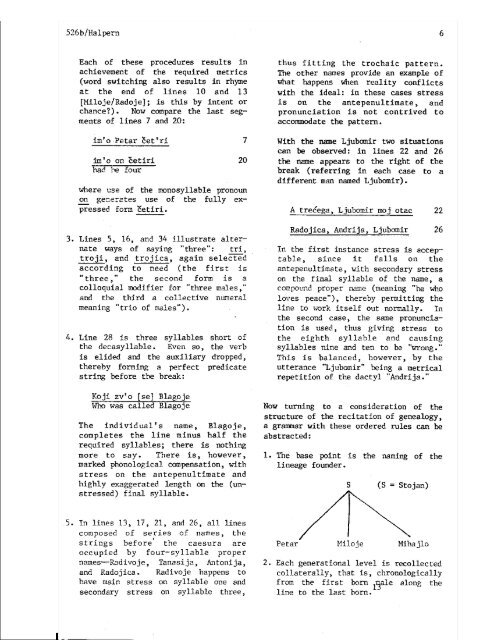Yugoslavia
Yugoslavia
Yugoslavia
You also want an ePaper? Increase the reach of your titles
YUMPU automatically turns print PDFs into web optimized ePapers that Google loves.
526b/Halpern<br />
Each of these procedures results in<br />
achievement of the required metrics<br />
(,;ord s,;itching also results in rhyme<br />
at the end of lines 10 and 13<br />
[Hiloje/Radoje]; is this by intent or<br />
chance?). No,; compare the last segments<br />
of lines 7 and 20:<br />
1m'o Petar cet'ri<br />
im t 0 on cetiri<br />
hac! he four<br />
.mere use of the monosyllable pronoun<br />
on generates use of the fully expressed<br />
form cetiri.<br />
3. Lines 5, 16, and 34 illustrate alternate<br />
,;ays of saying "three": tri,<br />
troji, and trojica, again selected<br />
according to need (the first is<br />
.. three," the second form is a<br />
colloquial modifier for "three males,"<br />
and the third a collective numeral<br />
meaning "trio of males").<br />
l,. Line 28 is three syllables shott of<br />
the decasyllable. Even so, the verb<br />
is elided and the auxiliary dropped,<br />
thereby forming a perfect predicate<br />
string before tbe break:<br />
Koji zv'o [se] Blagoje<br />
\{ho ,;as called BlagoJe<br />
7<br />
20<br />
The individual's name, Blagoje,<br />
completes the line minus half the<br />
required syllables; there is nothing<br />
more to say. There is, however)<br />
marked phonological compensation, ,;ith<br />
stress on the antepenultimate and<br />
highly exaggerated length on the (unstressed)<br />
final syllable.<br />
5. In lines 13, 17, 21, and 26, all lines<br />
composed of series of names, the<br />
strings before' the caesura are<br />
occupied by four-syllable proper<br />
names-Radivoje, Tanasija, Antonija,<br />
and Radojica. Radivoje happens to<br />
have main stress on syllable one and<br />
secondary stress on syllable three,<br />
L_.<br />
thus fitting the trochaic pattern.<br />
The other names provide an example of<br />
what happens when reality conflicts<br />
with the ideal: in these cases stress<br />
is on the antepenultimate, and<br />
pronunciation is not contrived to<br />
accommodate the pattern.<br />
With the name Ljubomir two situations<br />
can be observed: in lines 22 and 26<br />
the name appears to the right of the<br />
break (referring in each case to a<br />
different man named Ljubomir) •<br />
A trecega, Ljubomir mo j otac 22<br />
Radojica, Andrija, Ljubomir 26<br />
In the first instance stress is acceptable,<br />
since it falls on the<br />
antepenultimate, with secondary stress<br />
on the final syllable of the name, a<br />
compound proper name (meaning "he who<br />
loves peece"), thereby permitting the<br />
line to ,;ork itself out nom.ally. In<br />
the second case, the same pronunciation<br />
is used, thus giving stress to<br />
the eighth syllable and causing<br />
syllables nine and ten to be ....'rong ...<br />
This is balanced, however, by the<br />
utterance ''Ljubomir'' being a metrical<br />
repetition of the dactyl "Andrija."<br />
Now turning to a consideration of the<br />
structure of the recitation of genealogy,<br />
a grammar ,;ith these ordered rules can be<br />
abstracted:<br />
1. The base point is the naming of the<br />
lineage founder.<br />
5 (5 = 5tojan)<br />
Petar Miloje Hihajlo<br />
2. Each generational level is recollected<br />
collaterally, that is, chronologically<br />
from the first born l'lale along the<br />
line to the last born.<br />
6


